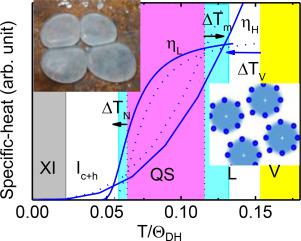Advances in Colloid and Interface Science ( IF 15.9 ) Pub Date : 2020-06-06 , DOI: 10.1016/j.cis.2020.102188 Chang Q Sun 1

|
Deep engineering of liquid water by charge and impurity injection, charged support, current flow, hydrophobic confinement, or applying a directional field has becoming increasingly important to the mankind toward overcoming energy and environment crisis. One can mediate the processes or temperatures of molecular evaporation for clean water harvesting, HO bond dissociation for H2 fuel generation, solidification for living-organism cryopreservation, structure stiffening for bioengineering, etc., with mechanisms being still puzzling. We show that the framework of “hydrogen bonding and electronic dynamics” has substantiated the progress in the fundamental issues and the aimed engineering. The segmental disparity of the coupled hydrogen bond (O:H
O or HB with “:” being lone pair of oxygen) resolves their specific-heat curves and turns out a quasisolid phase (QS, bound at −15 and 4 °C). Electrification shows dual functionality that not only aligns, orders, polarizes water molecules but also stretches the O:H
O bond. The O:H
O segmental cooperative relaxation and polarization shift the QS boundary through Einstein's relation, ΔΘDx ∝ Δωx, resulting in a gel-like, viscoelastic, and stable supersolid phase with raised melting point Tm and lowered temperatures for vaporization TV and ice nucleation TN. The supersolidity and electro structure ordering provide additional forces to reinforce Armstrong's water bridge. QS dispersion and the secondary effect of electrification such as compression define the TN for Dufour's electro-freezing. The TV depression, surface stress disruption, and electrostatic attraction raise Asakawa's molecular evaporability. Composition of opposite, compatible fields eases the H
O dissociation and soil wetting. Progress evidences not only the essentiality of the coupled O:H
O bond theory but also the feasibility of engineering water and solutions by programmed electrification.
中文翻译:

水电气化:原理和应用。
通过注入电荷和杂质,对带电的载体,电流,疏水性约束或施加定向场来对液态水进行深度工程设计,对于人类克服能源和环境危机变得越来越重要。人们可以介导用于干净水收集的分子蒸发的过程或温度,用于产生H 2燃料的H O键解离,用于生物体冷冻保存的固化,用于生物工程的结构加固等,其机制仍令人费解。我们表明,“氢键和电子动力学”框架证实了基本问题和目标工程方面的进展。偶联氢键的分段差异(O:H
O或HB,其中“:”是一对孤立的氧)解析了它们的比热曲线,得出了准固相(QS,在-15和4°C下结合)。电气化显示出双重功能,不仅可以对齐,排列,极化水分子,而且可以拉伸O:H
O键。将O:H
ö节段性协同松弛和偏振移位通过爱因斯坦关系的QS边界,ΔΘ DX αΔω X,产生凝胶状,粘弹性的,并且具有凸起熔点T稳定超固体相米和降低的温度为汽化Ť V和冰成核T N。超坚固性和电子结构有序提供了额外的力量,以加强阿姆斯特朗的水桥。QS的分散性和电气化的次要作用(例如压缩)定义了Dufour的电冻结的T N。T V降低,表面应力破坏和静电吸引提高了Asakawa的分子蒸发性。相反的,相容的场的组成简化了H
O的离解和土壤润湿。进展不仅证明了O:H
O键耦合理论的必要性,而且证明了通过程序化电气化工程用水和解决方案的可行性。









































 京公网安备 11010802027423号
京公网安备 11010802027423号